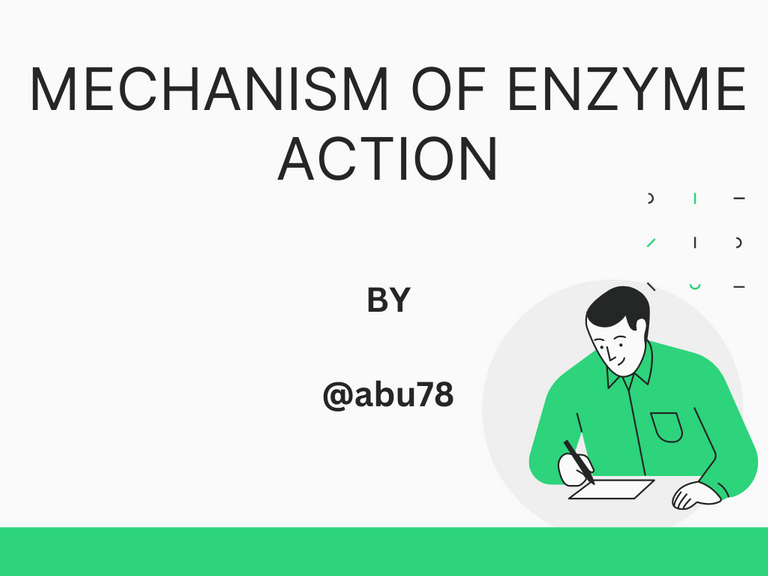Mechanism of Enzyme Action - A compendium explanation to your understanding
Greetings everyone here once again, I am here again to write and share with you all my science-related articles again. Today I would be tackling the mechanism of enzyme action. Without much ado, let's dive into the topic now.

Before everything we first look at the definition of enzymes. Enzymes are biological catalyst that speeds up biochemical reactions without themselves being part of the reaction. They do not undergo any chemical change after speeding the reaction indicating they just lower the activation energy so the reaction can be reached faster.
In representing it chemically, substrate + enzyme = product + enzyme.
Generally, the mechanism of enzyme action includes three steps and they are, the initiation stage, transition state facilitation, and termination stage. Initiaton stage involves the process where the reactants binds with the active site to form an enzyme-substrate complex and they do so in specific orientations.
Secondly, the transition state facilitation is where there is lowering of the activation energy which is due to the intersection existing between the enzyme and substrate. Lastly, the termination stage is when the products are formed and released because they do not possess any affinity for the active site. We should note that at this stage the enzyme also comes out unchanged.
Mechanism of enzyme action uses two steps to facilitate catalysis and they include; thermodynamic changes and processes at the active site. The thermodynamic changes involves the energy changes or differences that occurs when a substrate reacts or undergoes a chemical reaction to form a product. The activation energy is the difference in free energy that exists between the substrate and the transition state in a chemical reaction.
Enzymes fastens a reaction by providing a transition state that has a lower activation energy than the normal reaction process. This creates a new path of lower activation energy indicating that more molecules can reach the transition state for the formation of products.
We should note that the activation energy for a non-catalyzed reaction is higher than a the activation of a catalyzed reaction. Now we look at the processes at the active site as the second mechanism of action of enzymes. With this, four mechanisms or process are involved and they include the following; covalent catalysis, acid base catalysis, catalysis by bind strain, and catalysis by proximity and orientation.
The acid-base catalyisi usually are the oxidoreductase whereby histidine mostly acts the proton donor or a proton acceptor. Cysteine and aspartic acid when present play role in hydrogen transfer reaction during the process.
With the covalent catalysis, there is the formation of covalent intermediate that is formed between the substrate and the enzyme whereby the substrate is positioned to the active site of the enzyme. It introduces a new pathway than the non-catalyzed pathway. Mostly this reaction do occur in enzymes that catalysis group transfer reactions.
Furthermore, the catalysis by proximity and orientation occurs when substrates are able to bind at their active sites with the enzyme. Higher concentration of molecules is an indication of easy and faster reaction to occur. Lastly, we look at the catalysis by bond, where there is the formation of stained substrate from the induced structural rearrangements of the binding substrates. The stretches and strains makes it easy to bond or cleavage.
This is where I would end the mechanism of enzyme action topic. You can leave a comment in the comment section so we interact on this topic.
Thank you all for your time and attention.
The references given below are sites where you can learn more about the mechanism of enzyme action topic
Reference 1
Reference 2
Reference 3

Congratulations @abu78! You have completed the following achievement on the Hive blockchain And have been rewarded with New badge(s)
Your next target is to reach 15000 upvotes.
You can view your badges on your board and compare yourself to others in the Ranking
If you no longer want to receive notifications, reply to this comment with the word
STOPCheck out our last posts:
Support the HiveBuzz project. Vote for our proposal!
Thanks for your contribution to the STEMsocial community. Feel free to join us on discord to get to know the rest of us!
Please consider delegating to the @stemsocial account (85% of the curation rewards are returned).
Thanks for including @stemsocial as a beneficiary, which gives you stronger support.
Why do you use #leofinance tag on this post?
Please read this:
https://leopedia.io/faq/#what-kind-of-content-can-i-post-on-leofinance
Posted Using LeoFinance Beta